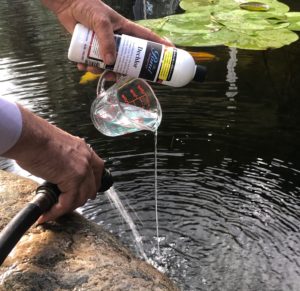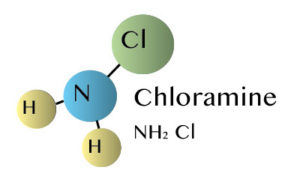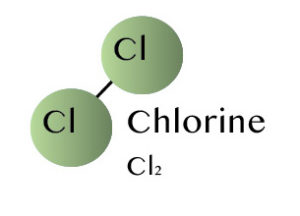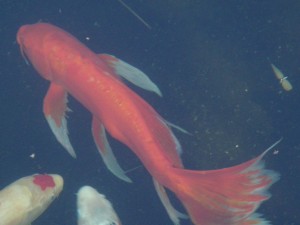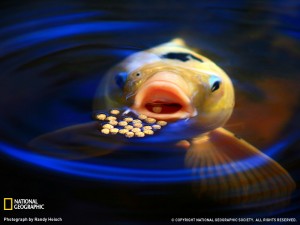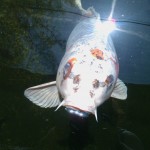When adding water to a pond, the tap water that comes from your hose contains chlorine and chloramines, which are harmful to your fish. Chlorine is toxic to most aquatic life, and it can cause stress and bad burns to the fish once it reaches the gills and its internals. Chlorine will cause burns upon contact, damaging the gills, scales, and breathing tissue of goldfish and koi. Also, interestingly, it readily enters the blood stream after it passes through the gills, causing internal burning, stress, and significant pain to the fish. The solution to this is to add the Pond Company’s Dechlor. Dechlor is short for a water dechlorinator, which is a water conditioner that neutralizes the chlorine, chloramine, and other heavy harmful substances. Dechlor should always be used whenever we add water to a pond, and whenever we do a water change to neutralize the chemicals before they affect the fish and the ecosystem. A bottle of the Pond Company’s Dechlor can be purchased for only $17.95 (see store), please give us a call if you are interested in purchasing (626)-284-5937 or drop us an email at: info@thepondcompany.com.
Chlorine & Chloramine Kill!
What is Chloramine?
Chloramine is used to bond chlorine to water. It is added by our metropolitan water districts in combination with chlorine to sanitize and disinfect the tap water that comes to your home and business. Sanitize kills everything living without discretion, including your fish!
Chloramines first started to be used in the 1980s. Prior to that time, Chlorine would rapidly dissipate from the water, but Chloramines make Chlorine stay in the water for a longer period of time.
Chloramines are a group of chemical compounds that contain Chlorine and Ammonia. Chloramine locks Chlorine and Ammonia to the water molecule, so it stays active in the water for a longer period of time.
Although we are told that the use of Chloramine in our water makes it safe for humans to drink (debatable given all the bottled water we buy), it is definitely harmful to fish. Chloramines are toxic to fish, because the fish will take up chloramines directly through their burned gills into their blood stream – not good! We recommend that the water used for your pond always be free of Chloramines. (See blog on how to treat for Chlorine & Chloramine)
The Life Cycle of a Mosquito
 There are 2500 different type of mosquito species throughout the world of which 150 of those species are in the Untied States. 52 species occur here in California. All mosquitos must have water to complete their life cycle. The water can range from snow melt to sewage effluent and it can be in any container imaginable. Mosquito larvae are identified by the type of water they lay their eggs in. The adults also show a preference for the type of sources in which to lay their eggs. They lay their eggs in places like tree holes that hold water, tide water pools, sewage effluent ponds, irrigated pastures, rain water collect, ect.
There are 2500 different type of mosquito species throughout the world of which 150 of those species are in the Untied States. 52 species occur here in California. All mosquitos must have water to complete their life cycle. The water can range from snow melt to sewage effluent and it can be in any container imaginable. Mosquito larvae are identified by the type of water they lay their eggs in. The adults also show a preference for the type of sources in which to lay their eggs. They lay their eggs in places like tree holes that hold water, tide water pools, sewage effluent ponds, irrigated pastures, rain water collect, ect.
Mosquitos have unique feeding habits in which the female mosquito will feed on man and other animals. The male mosquito feeds only on plant juices. Some female mosquitos prefer to feed on one type of animal or they can feed on a variety. Female mosquito feed on man, domestic animals, such as cattle, horses, goats, etc; all types of birds; all types of wild animals and they also feed on snakes, lizards and frogs.
Female mosquitos need to get a sufficient blood supply to develop eggs. If they don’t get this meal, then they will die without laying eggs. There are some species that can lay viable eggs without getting a blood meal.
The length of life of the adult mosquito depends on different factors: temperature, humidity, sex of the mosquito and time of year. The male mosquito lives very short time, which is about a week; and females live about a month depending on the above factors.
There are four distinct stages of life that a mosquito goes through: Egg, Larva, Pupa, and Adult.
Eggs: The eggs are laid one at a time and float on the surface of the water. Culex and Culiseta species, the eggs are stuck together in rafts of a hundred or more. Anopheles and Aedes species do not make egg rafts but lay their eggs separately. Culex, Culiseta, and Anopheles lay their eggs on water, but Aedes lays their eggs on damp soil that will be flood with water. Most eggs will hatch into larvae within 48 hours.
Larva: Larva live in the water and swim to the surface to breathe. After each molting, they shed their skin four times growing larger. Most larvae have siphon tubes for breathing and hang from the surface of the water. Larva feed on micro-organisms and organic matter in the water. The larva changes into a pupa on the fourth molt.
Pupa: The pupal stage is a resting, non feeding time. This is when the mosquito turns into an adult. It will take about two days before the adult is fully developed. The pupal skin will split and the mosquito will emerge when development is complete.
Adult: The adult mosquito will rest on the surface of the water for a short time to let itself dry and all its parts harden. This will give the wings a chance to dry so it can fly off.
Temperature play a big part during the life cycle of a mosquito. For instance, the Culex tarsalis might go through its life cycle in 14 days at 70 F and take only 10 days at 80 F.
The Answer: Mosquito Fish
Healthy Diet for your Fish
When a 4 kilogram pet gourami named Gary was moved to the Sea Life London Aquarium, he went on a hunger strike and refused to eat the fruit given to him. Eventually, the aquarium staff found out why he was shunning the natural diet of a gourami Gary had been raised on Kit Kats only.
I have never heard of a fish being fed chocolate, let alone being brought up entirely on the stuff, says Gary handler, Rebecca Carter. Gouramis usually eat a diet of fruit but Gary doesn’t appear to have suffered any ill effects from his chocolate addiction. However, we would not recommend feeding fish confectionery of any kind.
The aquarium personnel is now squeezing crushed pieces of Kit Kat into grapes in an effort to change Garys diet.
Fish being fed strange or simply suboptimal food by their keepers is unfortunately very common. Even well-intentioned fish keepers sometimes fail to realize that the various fish species in the world have developed to fit into different ecological niches and a diet that is perfect for one species might be highly unsuitable for another. However, keeping fish on a chocolate coated wafer diet is probably quite unusual.
Another problem is of course people getting fish without making the effort to find out how large the little juveniles they see in the fish shop may grow as fully mature adults.
Many people don’t do the right research when they buy fish and end up unable to care for them, says Carter. Catfish are a good example and we have a number here that outgrew their homes. We simply do not have the space to accommodate the vast number of re-homing requests we receive.
Facts
- Gourami are freshwater fish belonging to the family Osphronemidae. Currently, there are roughly 90 described species divided into four subfamilies and about 15 genera. The most famous gourami species is arguably Betta splendens, the Siamese fighting fish. Gourami is native to Asia where they are found from Pakistan to the Malay Archipelago and Korea.
- Kit Kat is a chocolate coated wafer confection produced by Nestlé and The Hersey Company. Each bar consists of fingers that can be snapped from the bar one at a time. Each finger is made up of three layers of wafer and an outer layer of chocolate. Kit Kat was invented at Rowntree’s, a confectionery company based in York, UK.
Stressed Out Koi
Koi keeping is an important part of Pond Care and stress is an impending part of it. We all go through stress in our lives to being uncomfortable and new to something. Fish living out in nature would simply swim away from stressful conditions, but when they are confined in a pond or tank there is no way for them to swim away. Ammonia levels can get too high and this can cause them a lot of stress. Fish have a hard time dealing with change in their environment, including temperature. That is why when you move any fish from one water source to another they need to be acclimated before being put in. This goes for pH, hardness and alkalinity of its new home.
Feeding Fish
Feed fish what they want observe them, listen to the fish. They will let you know whether they are hungry or not. 15-20 minutes after placing the food in the water for the fish to eat, there should be no floating food left. If there is food, you have fed them too much.
Fish are cold-blooded animals. Their metabolism is based on the temperature of the water they live in. Warmer water creates faster metabolisms. Fish will eat more and need more food to survive. Colder water creates slower metabolisms in fish. They will eat less food. In fact, at 50 F / 30 C you stop feeding goldfish and koi. Below 50 F / 30 C if they do swallow food, the food will spoil before it passes out of their long intestinal track. This leads to all types of problems sickness, diseases, digestive problems, etc. Note that normally they will not eat when it is this cold and the uneaten food will only spoil, clog and over load your filter system, disturb the pond balance and possibly create an unhealthy and detrimental situation. Thus note at 50 F / 30 C and below DO NOT FEED YOUR FISH!
Start feeding once a day as the temperature warms in the spring. When it warms, koi can be fed multiple times a day. As the weather cools in the fall, gradually slow down on the quantity till you stop at 50 F.
Koi/Carp are bottom-feeding fish in nature. The barbs on either side of their mouths are used to tactilely feel along the bottom of a lake for food. They are omnivores. An omnivore is a kind of animal that eats either other animals or plants. Naturally, their diet would consist of worms, crustaceans, plant life, etc. We have trained koi to come to the surface with floating food for our own enjoyment.
Koi food companies are doing their best to create dietary mixtures in their foods and for the most part they are doing a good job. And yet there is still a belief that the dietary needs of koi are still most optimally met by augmenting a variety of foods some proteins, plants, starch, etc. This can include not just pelleted/processed foods, but also fruit sliced oranges, grapefruit, watermelon, grains -rice, wheat, bread.
Japanese Koi
The Japanese Koi are world wide known as beautiful fish composed of brilliant colors and markings. People who own these fish can tell you how wonderful it is to be part of their lives. There is a mysterious past that surround this awesome fish. A lot of people still wonder where they have originated from.
Koi is a Japanese name meaning Carp, but the original word comes from the latin word Cyprinus Carpio meaning Carp. Many people believe the Koi came from Japan, but it is understood that Japanese Koi have come from the waters of the Caspian Sea and around China. There are records of carp fossils found in China dating back 20 million years and showing early accounts of the first color mutations being bred in China.
It is unclear as to where Koi are from, but there are a lot of stories that Koi have been brought to Japan by the Chinese invasion. Another says that Japans emperor had kept Koi in 200 AD. The history of Japanese Koi is pretty vague. As to what really happed between the 2nd and the 17th century is an ongoing exploration still today.
Koi Facts
Life Span of Koi: 60+ Years
Great info from Ozarkkoi!
Determining the age of a koi fish, also known as nishikigoi, is not an easy task. Some signs to take into consideration are the variety, coloration, appearance and size of the koi fish in question.Lastly, the size of your koi fish will help determine its age. Mature nishikigoi can reach 36″ or more in length. If your koi fish is considerably smaller, it is younger in age or its growth has been stunted.
